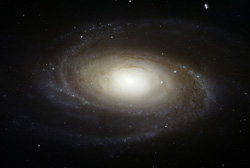Hubble photographs grand spiral galaxy Messier 81

The sharpest image ever taken of the large "grand design" spiral galaxy M81 is being released today at the American Astronomical Society Meeting in Honolulu, Hawaii. A spiral-shaped system of stars, dust, and gas clouds, the galaxy's arms wind all the way down into the nucleus. Though the galaxy is located 11.6 million light-years away, the Hubble Space Telescope's view is so sharp that it can resolve individual stars, along with open star clusters, globular star clusters, and even glowing regions of fluorescent gas. The Hubble data was taken with the Advanced Camera for Surveys in 2004 through 2006. This colour composite was assembled from images taken in blue, visible, and infrared light.
The galaxy is similar to our Milky Way, but our favourable view provides a better picture of the typical architecture of spiral galaxies. Though the galaxy is 11.6 million light-years away, the vision of the NASA/ESA Hubble Space Telescope is so sharp that it can resolve individual stars, along with open star clusters, globular star clusters, and even glowing regions of fluorescent gas.
The spiral arms, which wind all the way down into the nucleus, are made up of young, bluish, hot stars formed in the past few million years. They also host a population of stars formed in an episode of star formation that started about 600 million years ago. The greenish regions are dense areas of bright star formation. The ultraviolet light from hot young stars are fluorescing the surrounding clouds of hydrogen gas. A number of sinuous dust lanes also wind all the way into the nucleus of Messier 81.
The galaxy’s central bulge contains much older, redder stars. It is significantly larger than the Milky Way's bulge. The central black hole is 70 million solar masses, or 15 times the mass of the Milky Way's black hole. Previous Hubble research shows that the size of the central black hole in a galaxy is proportional to the mass of a galaxy’s bulge.
Messier 81 may be undergoing a surge of star formation along the spiral arms due to a close encounter it may have had with its nearby spiral galaxy NGC 3077 and a nearby starburst galaxy (Messier 82) about 300 million years ago. Astronomers plan to use the Hubble image to study the star formation history of the galaxy and how this history relates to the neutron stars and black holes seen in X-ray observations of Messier 81 with NASA’s Chandra X-ray Observatory.
Messier 81 is one of the brightest galaxies that can be seen from the Earth. It is high in the northern sky in the constellation Ursa Major, the Great Bear. At an apparent magnitude of 6.8 it is just at the limit of naked-eye visibility. The galaxy's angular size is about the same as that of the Full Moon.
The Hubble data was taken with the Advanced Camera for Surveys in 2004 through 2006. The colour composite measures 22,620 x 15,200 pixels and was assembled from images taken in blue, visible, and infrared light. It was released today at the American Astronomical Society Meeting in Honolulu, Hawaii, USA.
Media Contact
More Information:
http://www.spacetelescope.org/news/html/heic0710.htmlAll latest news from the category: Physics and Astronomy
This area deals with the fundamental laws and building blocks of nature and how they interact, the properties and the behavior of matter, and research into space and time and their structures.
innovations-report provides in-depth reports and articles on subjects such as astrophysics, laser technologies, nuclear, quantum, particle and solid-state physics, nanotechnologies, planetary research and findings (Mars, Venus) and developments related to the Hubble Telescope.
Newest articles

Redefining Cancer Science: Rodents, Humans, and the PD-1 Puzzle
Results of a comprehensive analysis refute assumptions that a key immune checkpoint receptor functions the same in rodents and humans The Discovery of PD-1: A Milestone in Cancer Treatment Since…

Heart Surgery Risks: Low BP Linked to Postoperative Kidney Injury
First large cohort study at the Heart and Diabetes Center NRW awarded – Hilke Jung presents research project at the FoRUM conference of the Ruhr University Bochum A working group…

Microbial Secrets: Boost Plant Growth with the Power of Soil Bacteria
To stay healthy, plants balance the energy they put into growing with the amount they use to defend against harmful bacteria. The mechanisms behind this equilibrium have largely remained mysterious….



